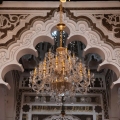The sky is grey. An air-raid siren pierces the early morning calm, followed by the distant thud of an explosion. Along a cobbled street, a group of men dressed in white – kippot, curled sidelocks, some draped in prayer shawls – move quickly, not in fear but with purpose. They sing, some pray aloud, others sway softly as they descend toward the river for Tashlich, the ritual casting of sins into flowing water.
A military drone hovers above the city. A Ukrainian soldier watches silently from a nearby corner. The war is near, but these men have not come to hide. They have come to mark time, to begin again.
Despite travel warnings, closed borders, and the reality of martial law, over 35,000 Jewish pilgrims arrived in Uman in 2024 to observe Rosh Hashanah, the Jewish New Year, near the grave of their spiritual guide, Rebbe Nachman of Breslov. In the midst of an ongoing conflict that has engulfed much of the country, the pilgrimage has not only endured – it has taken on renewed symbolic weight.
Why do so many – primarily from Israel, but also from the United States, France, and across Latin America – travel across a continent to spend two days in provincial Ukraine, immersed in prayer, song, and dance? What history, what memory, compels this journey?
What is Rosh Hashanah and Why Travel for It?
Rosh Hashanah marks the beginning of the Hebrew calendar year. It inaugurates a ten-day period of spiritual reflection that culminates in Yom Kippur, the Day of Atonement. Traditionally, this is a time for reviewing past deeds, seeking forgiveness, and beginning anew.
For followers of Breslov Hasidism – a mystical movement within Orthodox Judaism – Rosh Hashanah carries particular resonance. Their leader, Rebbe Nachman (1772–1810), taught that the New Year was a moment of soul-renewal. He instructed his followers to be with him on this date, both in life and in death. His tomb in Uman became the focal point of this instruction.
Origins in Ukrainian Soil
Hasidism emerged in the 18th century in what is now western Ukraine. Founded by the Baal Shem Tov, a healer and itinerant teacher, the movement emphasized emotional connection, spiritual joy, and divine presence in daily life. Its practices contrasted with the scholarly focus of other Jewish traditions, embracing song, dance, and fervent prayer.
The Breslov branch, founded by Rebbe Nachman, is distinctive for its lack of a living leader. Instead, the community continues to center around the teachings and memory of its founder.
Hasidic attire is rooted in 19th-century Eastern European norms: long coats (bekishe), fur hats (shtreimel) for holidays, white shirts, dark trousers, and sidelocks (peiyot). During the Uman pilgrimage, however, these traditions blend with a more informal style: knitted kippot, backpacks, white festival clothing, and spontaneous singing in the streets. For many locals, the scene resembles both religious procession and festival.
A Tomb Turned Destination
Rebbe Nachman requested burial in Uman, then a site of 18th-century anti-Jewish violence. He wished to rest among martyrs. He also asked that his followers visit his grave each Rosh Hashanah. “My Rosh Hashanah is everything,” he said. The pilgrimage, initiated by his disciple Reb Noson in 1811, became central to Breslov identity.
Over the centuries, the practice persisted through pogroms, Soviet repression, and even the Holocaust. During the USSR era, small groups crossed borders in secret to pray by the grave. After 1991, as Ukraine opened to the world, the pilgrimage expanded rapidly—from dozens to tens of thousands. By 2018, attendance peaked at 40,000.
Rabbi Nachman of Breslov: Pilgrimage, Memory, and the Uman Gathering
A City Remade
During Rosh Hashanah, Uman transforms. Streets close, homes are rented at high prices, signage switches from Cyrillic to Hebrew. Temporary medical centers appear. Kosher kitchens operate at scale. Even an Israeli consular outpost is temporarily established.
The pilgrimage is not a quiet event. It is loud, crowded, emotional. There are communal meals, public Torah study, dancing in the streets, the sounding of the shofar. Yet it is also contentious. Some residents criticize the disruption, unregulated commerce, and late-night revelry. In response, Israel has stationed police to help manage public safety.
Still, beneath the noise, the atmosphere can feel charged with purpose. The city’s usual rhythms give way to a collective intensity—voices raised in dozens of languages, street corners filled with song, classrooms and courtyards turned into places of study and remembrance.
Pilgrimage Under Fire
Following Russia’s 2022 invasion of Ukraine, many assumed the pilgrimage would be canceled. Ukrainian officials discouraged it. Uman, though not on the front lines, had suffered missile attacks. Yet in 2022, 23,000 arrived. In 2023, over 30,000. By 2024, despite war and danger, the number rose again.
Pilgrims reroute through Poland, Moldova, or Romania, traveling long hours by bus. Some speak of fear; others express calm. One Israeli traveler in 2024 put it succinctly:
“The war doesn’t scare me. I come from a country at war too. I came because this is where my soul is.”
The pilgrimage has even entered geopolitical calculations. Reports in 2024 suggested that Israel’s delivery of Patriot missile systems to Ukraine was part of broader negotiations that included support for the pilgrimage. A spiritual journey has, in this context, become a diplomatic variable.
Uman as Compass
The image of thousands praying under threat of bombardment may seem surreal. But in Uman, it has become a ritual of defiance and renewal. In the shadow of war, the pilgrimage affirms continuity—not through ideology, but through shared action.
Rebbe Nachman promised neither miracles nor safety. He offered a vision: that every soul is worth redeeming. That message, voiced across centuries and in the midst of conflict, still draws thousands to this corner of Ukraine each year.
Each Rosh Hashanah, Uman becomes a focal point of human resilience. Amid sirens and uncertainty, it is a place where people gather to begin again.




